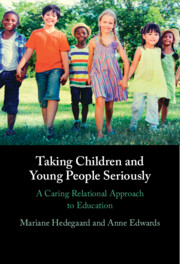Book contents
- Taking Children and Young People Seriously
- Taking Children and Young People Seriously
- Copyright page
- Contents
- Figures
- Tables
- Chapter 1 Taking Children and Young People Seriously
- Chapter 2 A Cultural-Historical Approach to Children’s Development and Childhood
- Chapter 3 Working Relationally with Other Professionals and Families
- Chapter 4 Very Young Children
- Chapter 5 Care and Education in Kindergarten with Play as the Core Activity
- Chapter 6 Engaging with Knowledge When Starting School
- Chapter 7 Caring Approaches to Pedagogy
- Chapter 8 The Primary School Age
- Chapter 9 Developmental Teaching as a Double Move between Subject Knowledge and Children’s Appropriation of Personal Knowledge
- Chapter 10 Adolescence and Transitions into Early Adulthood
- Chapter 11 A Caring Relational Approach to Education
- References
- Index
Chapter 4 - Very Young Children
Taking a Double Perspective in Understanding Their Development
Published online by Cambridge University Press: 08 June 2023
- Taking Children and Young People Seriously
- Taking Children and Young People Seriously
- Copyright page
- Contents
- Figures
- Tables
- Chapter 1 Taking Children and Young People Seriously
- Chapter 2 A Cultural-Historical Approach to Children’s Development and Childhood
- Chapter 3 Working Relationally with Other Professionals and Families
- Chapter 4 Very Young Children
- Chapter 5 Care and Education in Kindergarten with Play as the Core Activity
- Chapter 6 Engaging with Knowledge When Starting School
- Chapter 7 Caring Approaches to Pedagogy
- Chapter 8 The Primary School Age
- Chapter 9 Developmental Teaching as a Double Move between Subject Knowledge and Children’s Appropriation of Personal Knowledge
- Chapter 10 Adolescence and Transitions into Early Adulthood
- Chapter 11 A Caring Relational Approach to Education
- References
- Index
Summary
Through communication with caregivers, infants and toddlers come to orient intentionally to the world and their agency begins to unfold, initially through sharing intentions with adults. We show how the child’s emotional orientation to the world in the first three years of life happens through communication and is characterized by developmental periods that encompass other psychic functions. To understand children’s social situation from the child’s perspective, we have emphasized the need to attend to the child’s relations with others. We have therefore proposed taking a double perspective by focusing on both the child and the adults in their worlds. This is because the experiences of these very young children have to be seen in relation to how they are mediated by their caregivers. When caregivers or researchers orient to children’s perspectives, they never access it as a first perspective but always as a second, a relational, perspective and here we argue for Hedegaard’s formulated approach of the interactive observation. This method advocates a double perspective when researching children’s development, as the observations are mediated through the researcher’s experience.
Keywords
- Type
- Chapter
- Information
- Taking Children and Young People SeriouslyA Caring Relational Approach to Education, pp. 68 - 100Publisher: Cambridge University PressPrint publication year: 2023
- 1
- Cited by

